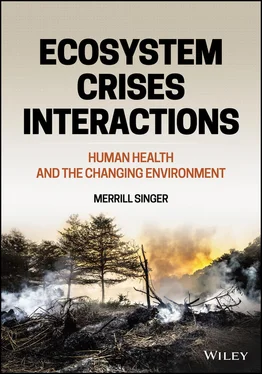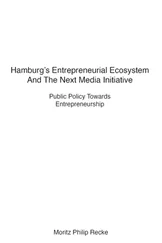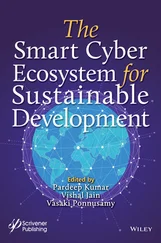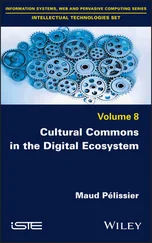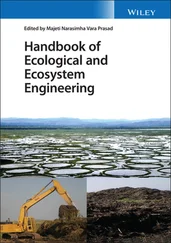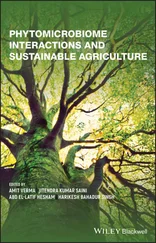
Fig. 2.1 Ivy growing on a tree.
Source: Free‐Photos/Pixabay.
Theophrastus’ final aspect of plants, one critical to the issues addressed in this book, is human agency, “which may have a goal quite at variance with both the plant and the environment” (Hughes 1985, p. 296). Unlike Aristotle, Theophrastus did not think plants existed to serve humans. In his Metaphysics , he asserted that:
We must try to find a certain limit … both to final causation and to the impulse to the better. For this is the beginning of the inquiry about the universe, that is, of the effort to determine the conditions on which real things depend and the relations in which they stand to one another.
(Ross & Forbes 1967, p. 92)
Moreover, he argued that the purpose of a plant has nothing to do with humans, but rather is just what plants will do without human agency: grow and reproduce.
Interestingly, Theophrastus realized that humans could have an impact, through acts like drainage, on regional climate. He stated that:
The country around Larisa in Thessaly [in ancient and modern Greece], where formally, when there was much standing water and the plain was a lake, the air was thicker and the country warmer; but now that the water has been drained away and prevented from collecting, the country has become colder and freeing more common. In proof the fact is cited that formally there were fine tall olive trees in the city itself and elsewhere in the country, whereas now they are found nowhere, and the vine were never frozen before but freeze now often.
(quoted in Hughes 1985, p. 303)
Further, he documented that deforestation could influence climate, noting that on the island of Crete, once heavily forested, extensive commercial logging and timber export had enhanced the severity of the wind, to the point that agriculture became unsustainable for many years. In Philippi, a city in eastern Macedonia, he asserted that the combined effects of drainage and deforestation—a case of ecocrises interaction—moderated the climate by allowing wind to blow away freezing air. These observations indicate that human awareness of anthropogenic climate change is over 5000 years old. In Hughes’ (1985, pp. 304–305) view:
If [Theophrastus] failed as a consistent ecologist, it was in concentrating his attention on individual species. Unlike modern ecologists, he did not emphasize the complex net of relationships in biotic communities … But it is hard to criticize him too severely, because he was the first to set out on the journey of inquiry that we call ecology.
In the millennia since Theophrastus lived, the Mediterranean environment he knew and studied has changed greatly. As Anne Ehrlich & Paul Ehrlich (1980) observe:
The Greeks inherited a land covered by rich stands of oaks, pines, and other trees with thick, drought‐resistant leaves called a “sclerophyllous” forest, in the jargon of [modern] plant ecologists. But, as the Greek population expanded, it progressively destroyed the forests for firewood, charcoal (needed in firing pottery and other industrial processes), and lumber. The great trees were often burned by accident, too, or as part of a military operation, or simply to create more open pastureland. Soil erosion on the slopes of the rugged Greek hills helped prevent reforestation as did grazing and browsing animals, which killed the seedlings before they could establish themselves. Especially prominent in the latter role were goats … Our overall impression was that the once rich area is now a badly deteriorated land inhabited by relatively impoverished peoples who, today, are partly dependent for their survival on the influx of tourists coming to see the physical monuments of past civilizations.
The Lyceum, for example, was excavated and opened for public viewing in 2014. Tourist websites encourage a visit to the free site, to stroll peaceful surroundings filled with fragrant plants (many species of which were planted there in Aristotle’s time) and view the remains unveiled by archeologists. Meanwhile, in places like Crete, less than an hour’s flight from Athens, sea level rise—due to the combined ecocrisis effects of climate change and extensive coastal construction—is beginning to challenge the sustainability of the beach‐based tourist industry (Centre for Climate Adaptation 2018).
2.2.2 Indigenous environmental knowledge
All societies through time and location must contend with the opportunities and challenges presented by their environments. This requires the development of environmental knowledge and sustaining social practices. Failure to overcome challenges can lead to social collapse, leading in turn to reversion to less complex social organizations that put fewer demands on environmental resources. Failure can also lead to obliteration and complete depopulation. A case of social collapse and simplification is seen in Classic Mayan society. The indicators of this collapse are found in the archeological record, most notably in the abandonment of Maya cities like Palenque, Copán, Tikal, and Calakmulin, located in the southern Maya lowlands of Guatemala, Honduras, and Mexico, which were left to be swallowed up by the re‐expansion of surrounding forests between the 8th and 9th centuries. After the collapse, there was a significant decline in large‐scale architectural construction in the area, though Mayan communities continued to persist in the southern lowlands and Mayan people still inhabit the region today. There has been considerable debate among archeologists about the causes of the collapse of Classic Mayan society. Suggested reasons include a growth of population that could not be supported by the local environment given Mayan farming technology, epidemics that decimated the population, military conflict between competing city‐states, deforestation, loss of plant and animal biodiversity, and catastrophic environmental events, such as climate change and intense drought (Hodell et al . 1995; Webster et al . 2007). Some of these factors may have been connected. War, for example, can be driven by the demand for environmental resources, while deforestation can lead to a loss of biodiversity (Durham 1976; Giam 2017). It is likely that the knowledge and practices needed to meet the environmental challenges faced by the heavily populated city‐states of Classical Mayan society were inadequate, and that this played an important role in the collapse. This example underlines the importance of investigating a society’s environmental knowledge/beliefs and their practical utility and contribution to sustainability in the encounter with environment opportunities and threats and changing conditions.
Robert Paine (2005, p. 280), coiner of the ecosystem concept “keynote species,” proposed that:
ecology with its roots in “natural history,” whether that was stalking prey, keeping special mushroom (e.g., morel or truffle) sites secret, or the best spots to fish, was initially an individualistic endeavor. Deep knowledge of parts of the natural world was a requisite for survival.
However, precisely because it is a requisite for survival, deep knowledge of the natural world has always been social, not individual, as humans have survived as a species from our origin into the present because we live in interactive and mutually supportive groups.
Eriksen & Adams (2010, p. 1) note that various “terms have been used to describe the collective environmental knowledge and the shared cultural resource practices of indigenous peoples, including indigenous environmental knowledge , traditional ecological knowledge , and ethnoecology .” Hardesty (1977, p. 291) defines ethnoecology, for example, as “the systems of knowledge developed by a given culture to classify the objects, activities, and events of its universe.” Brosius et al . (1986, p. 187) bifurcate indigenous knowledge into two categories:
Читать дальше
